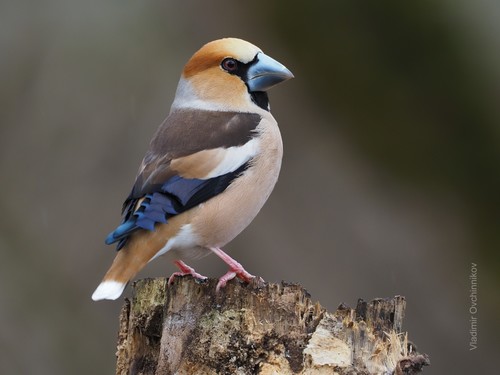
Hawfinch
The Hawfinch (*Coccothraustes coccothraustes*) is a striking and powerful finch, renowned for its massive bill capable of cracking open even the hardest of seeds and fruit stones. It plays a crucial ecological role in seed dispersal, particularly for trees with large, tough seeds that few other birds can manage. While not as widely recognized in popular culture as some other finches, the Hawfinch holds a quiet appeal for birdwatchers due to its elusive nature and distinctive appearance. It is a symbol of strength and resilience within its woodland habitats.
16.5-18 cm
Length
29-33 cm
Wingspan
Least Concern
Conservation Status
Distribution
The Hawfinch has a wide distribution across Europe and temperate Asia, extending eastwards to Japan. It is also found in parts of North Africa. Populations in northern and eastern Europe are partially migratory, moving south and west for the winter.
Lifespan
Typically 3-5 years in the wild, but can live longer.
Hawfinch's Habitat
Habitat Types
Deciduous woodlands, Mixed forests, Orchards, Parks with mature trees, Large gardens
Climate Zones
Temperate, Boreal (in some areas)
Adaptations
The Hawfinch's primary adaptation is its extraordinarily powerful bill and associated jaw muscles, which allow it to access food sources unavailable to most other birds. They also have relatively short, strong legs for perching on branches while manipulating large seeds.
Variations
Several subspecies are recognized, differing slightly in size, bill shape, and plumage coloration. For example, *C. c. japonicus* is found in Japan, and *C. c. nigricans* is found in Southern Europe.
Appearance
Breeding Plumage
Breeding plumage is more vibrant, with males showing a richer brown back, a black bib, and a bright blue-grey band on the wings. Non-breeding plumage is duller, with less contrast.
Seasonal Feather Changes
The bill color changes seasonally. It is a blue-grey in the breeding season, turning to a horn color in the winter.
Sex Based Plumage Differences
Males have brighter plumage and a more defined black mask and bib than females.
Notable Features
Massive, conical bill, Thick neck, Black mask and bib (more prominent in males), White wing bars
Diet and Feeding
Primary Foods
Seeds, Fruit stones (e.g., cherries, olives), Berries, Insects (especially during breeding season)
Foraging Behavior
Hawfinches forage both in trees and on the ground. They often perch on branches while cracking seeds with their powerful bills. They may also hop on the ground to pick up fallen seeds.
Specializations
The Hawfinch's bill is its defining specialization. The jaw muscles are exceptionally strong, allowing it to generate a force sufficient to crack open very hard seeds and fruit stones, such as cherry and olive pits.
Seasonal Diet Variations
The diet shifts seasonally, with a greater reliance on insects during the breeding season to provide protein for growing chicks. In winter, they rely heavily on seeds and fruit stones.
Behavior
Social Structure
Hawfinches are generally solitary or found in pairs, especially during the breeding season. Outside of the breeding season, they may form small flocks, sometimes mixed with other finch species.
Communication
A sharp, explosive 'tsik' call, A soft, warbling song (mainly by males during breeding season), Visual displays, such as head-bobbing and wing-flicking
Migration
Northern and eastern populations are partially migratory, moving south and west for the winter. Birds in milder climates may be resident year-round.
Territorial or Group Behaviors
Hawfinches are territorial during the breeding season, defending the area around their nest. They are less territorial outside of breeding, but may still show aggression towards other birds at feeding sites.
Conservation
Threats
Habitat loss (due to deforestation and changes in land use), Pesticide use (reducing insect prey), Climate change (potentially affecting food availability and breeding success)
Protection Programs
General habitat protection measures (e.g., protecting woodlands), Monitoring programs
Local National Laws
Protected under various national and international wildlife laws, such as the EU Birds Directive.
Population Trend
Stable
Population Estimates
The global population is estimated to be in the millions, but accurate figures are difficult to obtain due to the bird's elusive nature.
Interesting Facts
They can exert a force of up to 150 pounds per square inch with their bills.
This allows them to crack open incredibly tough seeds that are inaccessible to most other birds.
They are notoriously shy and difficult to observe.
Despite their bright plumage, they often remain hidden in the tree canopy.
Hawfinch flocks can strip a cherry tree clean.
Their attraction to these fruits makes them a minor pest in some orchards, although habitat loss has a greater impact.
Faqs about Hawfinch
What is the best way to attract Hawfinches to my garden?
Planting trees that produce large seeds or fruits, such as cherry, hornbeam, or beech, may attract them. Providing a source of fresh water can also help.
Are Hawfinches aggressive?
They can be aggressive towards other birds at feeding sites, especially during the breeding season. However, they are generally shy and avoid human contact.
How can I tell the difference between a male and female Hawfinch?
Males have brighter plumage, a more defined black mask and bib, and a more intense blue-grey patch on the wings.
Where can I find Hawfinches?
Look for Hawfinches in mature deciduous or mixed woodlands, especially those with trees that produce large seeds or fruits. Parks and large gardens with mature trees can also be good places to spot them.
Copyright @ Nature Style Limited. All Rights Reserved.
 English
English